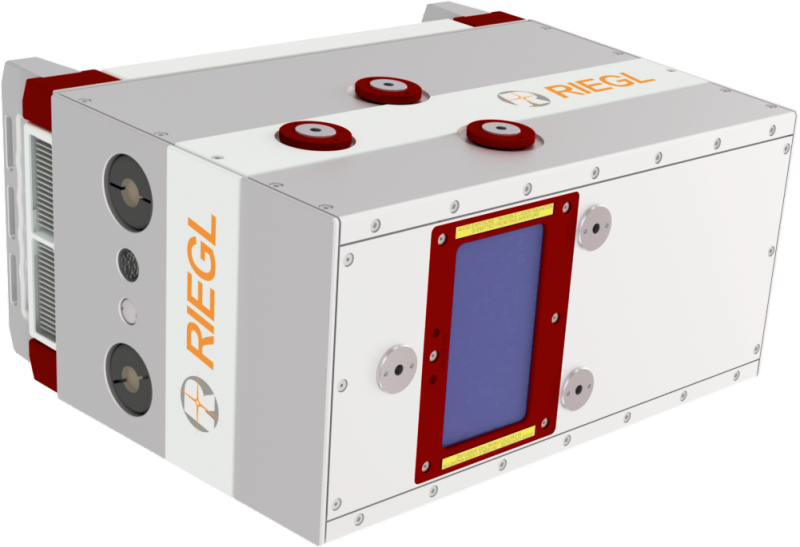The VQ-780 II-S is RIEGL’s latest high-performance, rugged, lightweight, and compact airborne laser scanner for wide area mapping applications with increased laser power. The laser scanner is designed for flush mount installations in aircraft hatches or external pods, and is ideal for integration with OEM or third-party peripherals. The RIEGL VQ-780 II-S provides up to 2 MHz Laser PRR and offers a range performance of up to 4800 m and an operating flight altitude of 12,800 ft when measuring natural targets with 20% target reflectivity. Like the VQ-780 II, the scanner provides 20 mm accuracy and the minimum range is given with 100 m.
The high-power laser sub-system provides twice the laser output power of the sister model VQ-780 II, resulting in a 1.4x range performance increase and a 25% increase in area collection efficiency. Conversely, the same range performance can be achieved with the new VQ-780II-S as with the VQ-780II, but at twice the measurement rate. With an effective measurement rate of up to 1.33 million laser pulses per second, the scanner offers homogenous point distribution and fast scan speeds of up to 300 scanlines/sec.
Point densities achievable cover a wide range and thus can be optimally adapted to the needs of applications: from data acquisition using 270kHz PRR at laser level 100%, which allows for 11,500 ft AGL at 160 kn platform speed resulting in 0.54 pts/m2 for an acquisition area of up to 960 km2 per hour to data acquisition using PRR 2000 kHz at laser level 6 % which allows for 2,500 ft AGL at 100 kn platform speed resulting in approx. 29.5 pts/m2 for an acquisition area of 130 km2 per hour.
A 'big leap' in laser performance
The RIEGL VQ-780 II-S scanning mechanism delivers parallel scan lines resulting in a regular point pattern on the ground. With equal spatial sampling frequency along and across track, object extents are well defined and even small objects may be detected. It is well suited for applications where superior point distribution on target surfaces is required.
The wide field of view of 60°, long measurement ranges at high pulse repetition rates at the same time, and the ability to resolve range ambiguities (multiple time around – MTA) make the instrument the tool of choice for wide area mapping applications. With its broad effective swath width, the necessary flight time for missions can be reduced to a minimum.
The most significant difference with the Mk II-S versus the Mk II is the difference in laser output power, which is twice that of the Mk II. This translates to a 1.4x increase in range performance, or a 25% increase in collection productivity in some collection scenarios.
“In fact, what can be collected with 1000 kHz at 2000m AGL (20% target reflectivity), can now be collected with 2000 kHz at the same altitude. The RIEGL VQ-780 II-S is a big leap in laser performance that yields tangible project cost savings to our customers”, adds Michael Sitar, Airborne Division Manager RIEGL USA.
“Productivity” is a constant theme with respect to sensor development and wide-area mapping, and clients are looking to the manufacturers to help reduce collection times and overall costs, says Sitar.
“A key enabler to that is the integration of the very latest laser power supplies for maximum output power per pulse. More energy at higher emission rates means longer range performance and/or higher point density. However, as range performance goes up, it is critical to maintain resolution, or beam footprint size on the ground. The RIEGL VQ-780 II-S includes a new laser beam collimator with a smaller beam divergence than the earlier Mk II, allowing similar data quality, albeit from higher altitudes.”
Working with high accuracy sub-systems
The VQ-780 II-S is designed to work with the latest high-performance INS/GNSS systems, flight management systems, and camera options. High-altitude sensors demand high accuracy sub-systems as angular errors at altitude translate to much larger errors on ground. For this reason, only the highest accuracy INS/GNSS solutions are offered with the RIEGL VQ-780 II-S. RIEGL’s standard solution includes the Applanix OEM AP60 with high-accuracy fiber optic IMU.
Medium format cameras are very popular peripheral sensors that are often included with RIEGL lidar scanners, says Sitar.
“In the case of the VQ-780 II-S, these are available as external bolt-on solutions that can be tightly integrated with the embedded POS solution for seamless and simultaneous collection of directly georeferenced, high-accuracy imagery. Our OEM supplier is Phase One, who provides our clients with numerous imaging options to choose from, including but not limited to, 100 and 150 MP RGB and/or NIR imaging options.”
“Recently, we have begun to offer Topoflight Flight Management Systems. This intuitive and easy to use software package provides our users with an alternative for mission planning and navigation. Many of the RIEGL sensors, including the VQ-780 II-S, are included in the Topoflight GUI for quick flight plan generation.”
Laser scanning for machine and deep learning algorithms
Reflecting on the current geospatial market, Sitar is proud to how RIEGL is able to contribute sensors and solutions that help bring actionable 3D data to stakeholders and end-users.
“What sets RIEGL apart is the targeted development of its products for specific applications. There is no one sensor that can address each application optimally. Instead, many applications can benefit greatly from sensors which have been designed to maximize data quality and fidelity for those specific applications.”
In the case of the RIEGL VQ-780 II-S, its matrix scan pattern (uniformly distributed points) lends itself extremely well to the machine and deep learning algorithms that are being used with increasing frequency for such things as ground classifications and feature extraction.








